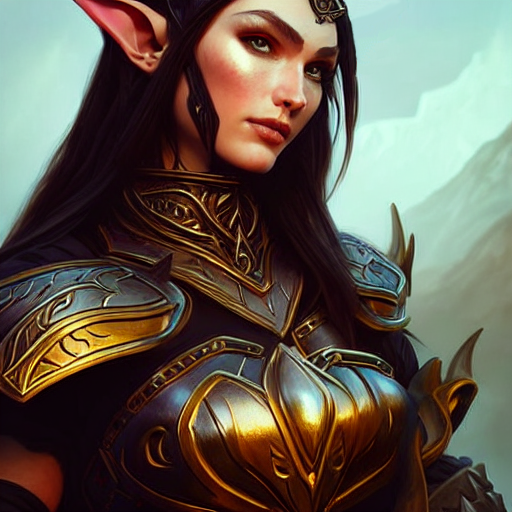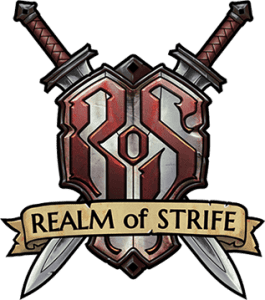Elf
Elves also retained most of the original humanoid form from before the Downfall, though they are typically taller and longer limbed that humans. Along with their lighter builds this gives their race an almost delicate appearance. Most telling of their features is their ears, larger than humans and coming to distinctive point, garnering elves the derogatory nickname of ‘Knife Ears”. While generally weaker than humans, they are superior in almost every other way, possessing a keen mind, quick reflexes, and a remarkable otherworldly beauty that seems to often catch the eye of humans in particular.
Elves have lifespans much long than any other race, thought to be proof that before the downfall, all of the Third creation possessed longevity of life. It is not unheard of for Elves to live for a thousand years before finally succumbing to the ravages of old age, though most elves will die of other causes long before reaching the natural end of their life cycle. As such, elderly Elves are rare and much revered. Elven children are also rare, for it is said that with so much time available to them relative to the other races, Elves seem to almost forget about the necessity of breeding in order to propagate their race.
Among Elves, there are two clear distinctions to be made, High Elf and Wild Elf.
Elf, High

The High Elves are those Elves who have used their long years to pursue art, literature, music, academics, law, and all the things that epitomize a highly civilized culture. They are expert craftsman and warriors, often spending the equivalent of an entire human lifespan simply training and honing their craft. Their historical records are some of the most complete archives, reaching back into ancient times, though always marked by a hint of racial superiority. Though they do not necessary look down on the other races as flawed and inferior, it must be considered that as a race they were exploring the higher mysteries of the cosmos and complexities of the mind and soul while humans were still discovering fire and developing spoken languages.
As some of the first peoples of the Third Creation to develop advanced societies most High Elven cultures are seen to be in their twilight, having grown to establish vast empires only to have slowly declined as other races, namely Humans, rose to dominance. What humans often seem to forget is that their own rise to dominance was likely only possible due to the sacrifices of the early Elven Kingdoms and Empires. For of all the Third Creation, Demons despise Elves most of all, perhaps because they are the most resistant to their corrupting influence, or even simply that they are said to still possess a measure of the angelic beauty of the Eternal Realm. Regardless, Elves and Demons have fought many long and destructive wars stretching far beyond the recorded histories of human kind. In many ways, High Elves have always been the sword that has kept the Demons at bay, sacrificing much to prevent them overrunning the Realm of Strife. Countless Elven Kingdoms have risen and fallen, with once great Empires now reduced to ashes, each owing its demise in some form to the demonic Abomination of Creation.
In modern times only two High Elven civilizations remain in the known world: the solitary and isolated City-State of Cailhast, once part of a great nation of Elves that covered most of the continent of Gant, and the Solastaris Elves of Norlanin, refugees from an unknown land carrying a foreboding secret as they are settle lands that once belonged to a vast empire of Elves in ancient times.
Affinity: Celestial/High Spirit Powers and Psionic Faith Powers (+5% Critical Hit Chance):
Resistant to: Natural (+5), Demonic (+5)
Stat Modifiers:
| STRENGTH | -2 |
| AGILITY | +1 |
| STAMINA | -2 |
| INTELLECT | +2 |
| WISDOM | +1 |
| AVOIDANCE | – |
| PERCEPTION | +2 |
| RESOLVE | +1 |
| INITIATIVE | +1 |
| CHARM | +2 |
| MOVEMENT | – |
Racial Passive: Willpower, Light of Foot
Racial Secondary Skill: Tailor OR Runecraft OR Craftsman/Tradesman (typically Jewel crafting or some other craft that involves delicate or precise handiwork)
Elf, Wild
Wild Elves share much in common with their High Elf cousins; size, stature, features, and long life spans. The commonalty ends there, however, for they possess a deep and almost spiritual connection with the natural world that is unique to their race and they are never willing to exploit it for the sake of advancing their civilizations. In many ways this has held them back as race, making them appear almost primitive to outside observers. This is not necessarily true—some Wild Elf civilizations are quite advanced in philosophy, art, and self governance, even building large empires and sprawling cities. There is always a marked difference between a Wild Elf settlement and any other, regardless of how primitive or advanced, for Wild Elves spend their long years shaping the environment around them to allow all living and growing things to live together in harmony. This doesn’t mean they reject activities essential to the survival of any race, such as hunting or harvesting timber, but in doing so they recognize that they are just one part of the grand cycle of the natural world.
This philosophy tends to place Wild Elves at odds with the rest of the world, for most of the other races view themselves as the dominate form of life with an inherit right to exploit the natural world for their own benefit. Throughout the long history of the Realm of Strife, this has led to conflicts beyond counting, from small skirmishes to all out warfare.Though most Wild Elves tend to be reclusive by natural, they are quick to rise to the defense of their beloved forests and wild places of the world.
Wild Elves are most often found in tribal units, living as nomads within the deepest forests and most remote hills. When they feel their presence in a particular area has placed too much strain on the natural cycle of life they move on so that it may recover. When they do build permanent cities, they shape the very trees themselves into grand halls and sprawling terraces, so harmoniously designed that it can be difficult to distinguish them from the natural forest around them—a most clever form of defense.
Being of Elven heritage, Wild Elves too have drawn the ire of Demons from the very beginnings of the Realm of Strife. By their nature they tend away from direct conflict, preferring to strike hard and fast and then melt away into the forest. In Norlanin this tactic has served the Wild Elves of the Emladrian Forest well for thousands of years. The Emladrian Collective is thought to be one of the oldest known civilizations still in existence and is highly sophisticated in its own right. Despite countless outside threats, the many tribes of the collective have united to preserve their way of life and the forest they call home.
In Gant, many tribes of Wild Elves also exist under the sprawling canopy of the Athelnon Forest, however they have never united in the same way as the Emladrian Elves. Many of the tribes still war among themselves, none more violently that the savage Sablewood Tribe, who are said to offer captive human sacrifices to their dark primal gods.
Affinity: Nature/Wild Spirit Powers and Primal Faith Powers (+5% Critical hit Chance):
Resistant to: Natural (+5), Demonic (+5)
Stat Modifiers:
| STRENGTH | -2 |
| AGILITY | +2 |
| STAMINA | -2 |
| INTELLECT | +1 |
| WISDOM | +2 |
| AVOIDANCE | +1 |
| PERCEPTION | +2 |
| RESOLVE | – |
| INITIATIVE | +1 |
| CHARM | +1 |
| MOVEMENT | +1 |
Racial Passive: Animal Speech, Light of Foot
Racial Secondary Skill: Hunter OR Herblore OR Leather Worker
Half-elf
While half elves are not all together uncommon, in almost all cases they are the result of a union between a human and true-born elf, intermingling elven and human bloodlines. While elves and humans are different species entirely, some portion of their shared physiology allows for them to procreate. However, as a hybrid species, half-elfs are typically born sterile and cannot sire offspring of their own.
In extremely rare cases, or as a result of magic, other half elf bloodlines may exist. Regardless, the Elven bloodline is found to be very dominant, and as such Half-Elves strongly resemble true-born Elves. However they tend to be more muscular, and for males at least, their mixed heritage is most evident by the presence of facial hair, which is rather uncommon among true-born elves.
Affinity: Physical Ranged attacks/skills (+3% Critical Hit Chance)
Resistant to: Natural (+5), Demonic (+5)
Stat Modifiers:
| STRENGTH | -1 |
| AGILITY | +1 |
| STAMINA | – |
| INTELLECT | – |
| WISDOM | – |
| AVOIDANCE | +1 |
| PERCEPTION | +1 |
| RESOLVE | – |
| INITIATIVE | – |
| CHARM | +1 |
| MOVEMENT | – |
Racial Passive: Outcast, Half-Breed
Racial Secondary Skill: Performer OR Petty Thievery OR Haggler





